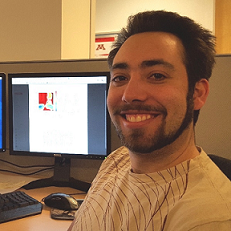| Colin S. Gaines |

Colin Gaines has successfully defended his thesis in virtual thesis defense. His research focuses on investigating the structure, dynamics, and reaction mechanism of the twister ribozyme through the use of a variety of computation tools including MD, QM/MM, and Constant pH MD simulations.
The abstract for Colin's dissertation can be found below:
With a recent surge in experimental work being conducted on catalytic RNA enzymes - or ribozymes - there was both a need and an opportunity to develop a comprehensive approach to the computional study of small nucleolytic ribozymes. In this dissertation, this approach to Computational RNA Enzymology is detailed (Chapter 2) and then applied to two recently discovered ribozymes. In Chapter 3, molecular dynamics simulations both in crystallo and in solution, along with molecular solvation theory, are leveraged to develop a model for the active state of the twister-sister (or TS) ribozyme in solution. An end-to-end study of the twister ribozyme, utilizing the full range of techniques involved in the Computational RNA Enzymology approach, is then presented in Chapters 4 and 5. Finally, Chapter 6 discusses how the insights gained from atomically detailed models of individual ribozyme systems resulted in the discovery of a catalytic core common to a majority of naturally occuring small-nucleolytic ribozymes as well as an artificial DNAzyme. The structure-function relationships gleaned from the computional work conducted on these ribozymes not only allows for the interpretation of experimental data, but also provides for experimentally testable preditions to guide future studies. Continuing to look forward, the characterization of a generalizable structural scaffold supporting catalysis may open the door to rational design of novel therapeutics built using catalytic RNA.
